|
|
 |
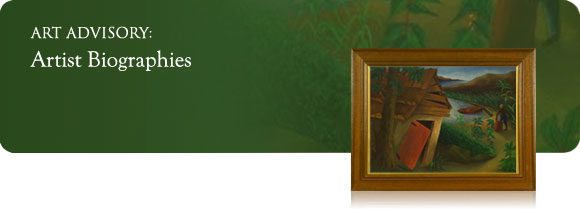
Alphabetical
A | B | C | D | E | F | G | H | I | J | K | L | M | N | O | P | Q | R | S | T | U | V | W | X | Y | Z
Radulovic, Savo
Rauschenberg, Robert
Reed, Kenneth
Reeves, Richard Stone
Rembski, Stanislav
Remington, Frederic
Robb, Laura
Rockwell, Norman
Rogers, Gretchen W.
|
Roos, Philipp Peter
Roseland, Harry Herman
Rosell, Juan
Rosenquit, Bernard
Rosenthal, Seymour
Rouault, Georges
Rozenvain, Michael
Russ, Robert
|
|
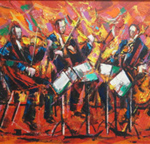
Savo Radulovic
1911-1991
Yugoslavian-born American modernist graphic painter
Savo Radulovic was born in Montenegro, Yugoslavia and later settled in New York City where he became an abstract painter, graphic artist, and teacher. He was the owner and director of the Artists Little Gallery from 1946 into the 1970s. Radulovic studied at the Saint Louis School of Fine Arts Washington University, the Fogg Museum of Art at Harvard University, and on a Fulbright Scholarship in Rome at the Academie Belle Arte. His works were exhibited in St. Louis, Pennsylvania, and New York galleries, and he is included in various museum collections. Radulovic died in December of 1991.
|
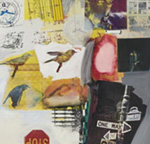
Robert Rauschenberg
1925-2008
American assemblage, Pop Art, and Abstract Expressionist
Robert Rauschenberg was born in 1925 in Port Arthur, TX. In 1947, he attended Kansas City Art Institute, followed by Academie Julian in Paris in 1948. Disenchanted with the European art scene, he returned to the US to attend Black Mountain College in 1949. It was here that Rauschenberg studied under abstract painter Josef Albers and formed professional relationships with John Cage and Merce Cunningham. He then moved to NYC, where he studied further at the Art Students League until 1952. Some of his first works included collage. Rauschenberg’s “combine paintings” of the 1950’s combined at first paint and objects from his own past, but then began to include more “found objects” that had no personal connection to the artist. He dabbled in planning and costuming stage performances in the 1960s, and in the 1970s he constructed artworks of fragile and ephemeral materials. Stylistic choices in his works show ideas from Pop Art, Abstract Expressionism, Conceptualism, and Dada. Unlike his contemporaries, he had restless inventiveness, which makes his works and style difficult to categorize. In January 1998, the Guggenheim exhibited a retrospective of his works, covering his career of more than 50 years, which pushed him to the public forefront.
|
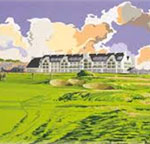
Kenneth Reed
-
Kenneth Reed is best known for his golfing art, having designed the official posters for the Open and U.S. Open Championships, as well as commissions by such golfing greats as Gary Player, Bob Charles, Greg Norman and Tom Weiskopt for their own homes. His clients include the Royal and Ancient Golf Club of St. Andrews and the United States Golf Association.
|
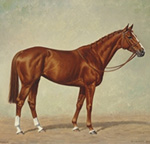
Richard Stone Reeves
1919-2005
American horse portrait painter
Richard Stone Reeves was born in 1919 in Manhattan, NY. He earned his BA in 1941 from Syracuse University and served in naval intelligence in China during World War II. One of his superior officers was Bob Johnson, President of Roosevelt Raceway. Johnson too note of the continual sketching of horses by Reeves and after the war he linked Reeves to further subjects for his paintings. In 1948, his portrait of racehorse, “Armed”, horse of the year the previous year, was on the cover of Life magazine, attracting many new commissions. Horse portrait commissions came from many prestigious owners such as Paul Mellon, W. Averill Harriman, and Harry Guggenheim. His subjects included race-winners Seattle Slew, Secretariat, Buckpasser, and Spectacular Bid. Paintings by Reeves are primarily in private collections and are in the permanent collection of the National Museum of Racing and Hall of Fame in Saratoga Springs, NY.
|
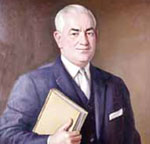
Stanislav Rembski
1896-1998
Polish portrait painter, active in Northeast America
Born in 1896 in Sochaczev, Poland, he was encouraged by his father to become an artist, and his interest flourished at an early age. While attending engineering school during World War I, Rembski began formal study at the School of Fine Arts in Warsaw. He was inspired by the works of Renaissance artists Albrecht Durer and Raphael. At the end of the war, he established a studio in Warsaw and participated in the Salon exhibits in 1918 and 1919. He later studied in Paris and Berlin. Rembski maintained a brisk portraiture practice in Germany before immigrating to America in October of 1922. He opened a studio in Brooklyn and in 1927 he was one of four emerging artists awarded the opportunity to show their work at the Dudensing Galleries in Manhattan. He married the same year and became an American citizen in 1929.
In 1931 he completed a triptych on the life of St. Bernard of Clairvaux for the St. Bernard School in Gladstone, NJ. Rembski’s portraiture practice often compelled him to travel to the south and in the early 1940s he left NY and moved to Baltimore. He was commissioned to paint posthumous portraits of Presidents Franklin D. Roosevelt and Woodrow Wilson. He remained in Baltimore, continuing to paint, until his death in 1998. His works remain in many American museum collections as well as private collections.
|
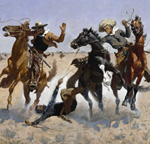
Frederic Remington
1861-1909
American illustrator and painter specializing in the “Old American West”
Frederic Remington was born in Canton, New York in 1861. His father was a colonel in the Civil War. He made drawings and sketches of soldiers and cowboys from an early age. Remington attended the art school at Yale University, where he found that he preferred action drawing. His first published illustration was a cartoon of a bandaged football played for the student newspaper. Later in life, Remington sketched and painted earnestly, in order to barter his sketches for essentials. He was soon successful enough for locals to see his art as a real profession. He moved to Brooklyn and studied at the Art Student’s League in New York. He worked for Harper Weekly, drawing commissions for the magazine and illustrated a book by Theodore Roosevelt titled Ranch Life and the Hunting Trail. Remington’s full color oil painting Return of the Blackfoot War Party was exhibited at the National Academy of Design. His fame made him a favorite of western Army officers fighting the last Indian battles. Remington was the most successful Western illustrator in the “Golden Age” of illustration. His style was naturalistic, sometimes impressionistic, and usually veered away from ethnographic realism of earlier Western artists. His focus was firmly on the people and animals of the West and the dominance of nature over man, and he was one of the first to illustrate the true gait of the horse in motion.
|
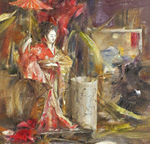
Laura Robb
b. 1955
American still life and landscape painter
The Tulsa, Oklahoma native, Laura Robb, entered art school at the age of sixteen, studying under Michael Aviano and Richard Schmid. Robb's paintings earned her a high honor when she received the John F. and Anna Lee Stacey Scholarship, a study stipend juried by members of the National Academy of Western Art in Oklahoma City, Oklahoma. She has since traveled and painted in France, Spain, Mexico, and Guatemala. Robb had been exhibiting in Oklahoma for 12 years, when she arrived in Taos, New Mexico in 1986. Three years later her reputation was established, and from that point Robb has moved steadily upward. Robb works in three mediums-oils, watercolors and pastels-but she is most drawn to the richness of oils. Although she is well known for her landscapes and figure studies, her primary focus always has been her still lifes. Robb is a teacher and workshop leader who has enjoyed the experience of helping others learn to paint, but is slowing down to dedicate more time to her own painting. Robb's interest in spontaneous gesture has led her to paint rather small paintings.
|
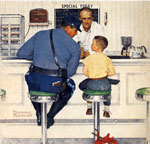
Norman Rockwell
1894-1978
American painter
Norman Rockwell was a 20th Century American painter and illustrator. His works are popular in the United States because they reflect the American culture. Rockwell is most famous for the illustrations he created for the cover of The Saturday Evening Post magazine for over four decades. Other works that are very popular, are those that he made for the Boy Scouts of America.
|
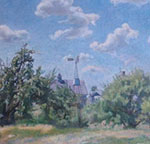
Gretchen W. Rogers
1881-1967
American, figure, still life, portrait, and landscape painting
Born as Margaret Rogers, but known as Gretchen, was one of the most promising young artists of the early 20th century in Boston. She studied with Edmund C. Tarbell and Frank W. Benson at the Museum School in Boston (1898-1906) and she became one of the most proficient painters from the Boston tradition. Her works are sensitively and carefully painted; she used subtle gradations in light and dark rather than harsh juxtapositions of color. Typically painting realistic portraits and interior genres with skill, her brushwork was refined and elegant with softened edges and a true sense of color harmonies as they relate to nature.
She quickly became a popular portraitist and figure painter and was given one-woman shows at the Guild of Boston Artists in 1917 and 1928. As early as 1911, she exhibited at the Museum of Fine Arts, Boston, and she became a frequent contributor to annual exhibitions at the Pennsylvania Academy of the Fine Arts, the Art Institute of Chicago, and the Corcoran Gallery. In 1915, she won silver medals at the 1915 Panama-Pacific International - San Francisco Exposition. In the 1930s, she submerged her career to domesticity and never painted again. She passed away in New Haven, Connecticut in 1967.
|
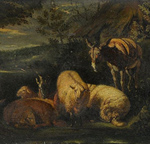
Philipp Peter Roos
ca. 1655–1706
German, active in Italy painter
Philipp Peter Roos, a.k.a Rosa da Tivoli and/or Mercurius, was born in Frankfort, Germany to a family of painters. In 1677, he went to Italy on a scholarship from the Landgrave of Hesse and studied in Rome under Giacinto Brandi. Around 1684, he bought a house near Tivoli, where he got one of his nicknames, Rosa da Tivoli, however from 1691 he seems to have lived mainly in Rome. Roos was a member of the Schildersbent, which gave him the nickname Mercurius because of the speed at which he painted. He painted almost exclusively domestic animals with their herdsmen in the Roman Campagna, depicting them in a lifelike manner. Roos died in 1706 in Rome.
|
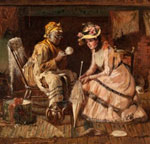
Harry Herman Roseland
1868-1950
American, narrative, genre, portrait and interior painting
Born in Brooklyn, New York, and staying there throughout his career, Harry Herman Roseland became a notable genre painter of the late 19th and early 20th centuries. Though he did study with J.B. Whittaker for a short time, Roseland was largely self-taught.
At a time when abstract art was gaining ascendency, Roseland chose to push against the current and paint what he saw in a realist style, focusing on landscapes and still lifes in his early career. His earlier subjects were sentimental, and depicted fashionable people, rural folk, and idealized farm scenes.
As Roseland developed his talent, he became aware of his natural flair for genre painting; each of his paintings were able to tell a story, evoke an emotion, or educate. He found his inspiration and focus in the post-Civil War blacks who formed the underpinning of Northeastern society, a topic setting him apart from his contemporaries. His clever, skillful scenes of homely activities, like checkers or letter-reading, were remarkably dispassionate and candid for the time, though to modern eyes they may seen condescending and dated.
During his career as an artist he exhibited: Brooklyn Art Club, 1888 (gold), Boston, Mass., 1900 (medal), 1904 (gold), Charleston Expo, 1902 (medal), National Academy of Design, 1898 (prize), Brooklyn Society of Artists, 1930 (prize), American Art Society, Philadelphia, 1902 (medal), 1907 (gold), Pennsylvania Academy of the Fine Arts, Art Institute of Chicago.
His memberships include: Brooklyn Arts Club, Brooklyn Society of Artists, Brooklyn Painters Society, Salmagundi Club.
|
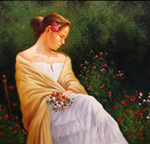
Juan Rosell
b. 1944
Spanish figural painter
Juan Monedero Rosell was born in the province of Albacete in 1944. He studied at La Escuela de Bellas Artes de San Carlos se Valencia. After residing in Italy and France for many years, he returned to his native Spain to continue his career as an artist. Many of his paintings include dreamy scenes of young and pretty women in countryside settings, using loose brushwork and rich colors. Rosell has participated in various exhibitions in the region of Valencia.
|
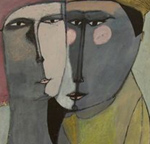
Bernard Rosenquit
1923-1991
American abstract/figural painter and printmaker
Bernard Rosenquit was born in Romania in 1923 and emigrated to the United States with his mother in 1929. He grew up in New York City, later making it a primary subject in his works. He studied in France at the Fontainebleau School of Fine Arts, in Sorbonne at the Institute of Art and Archaeology, in New York at the Brooklyn Museum School of Fine Art, the Art Students League, and Atelier 17. Rosenquit had many solo and group shows in both museums and galleries, including the Roko Gallery in New York, the Museum of Modern Art, NY, the Boston Museum of Fine Art, the US National Museum, Washington, D.C., and the Carnegie Institute in Pennsylvania. Additionally, his works are included in the collections of many major museums.
|
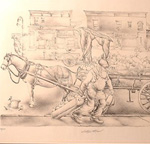
Seymour Rosenthal
b. 1921
American Jewish genre artist
Seymour Rosenthal was born in the Bronx in 1921. He was a natural sketcher from childhood. He drew sketches and drawings of his surroundings while working in the New York City garment center and went on to work as a lithographer. He was able to leave lithography and become a fulltime artist working with pencils, oils and watercolors.
|
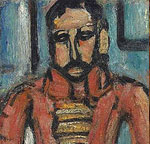
Georges Rouault
1871-1958
French Fauvist and Expressionist painter and printmaker
Georges Rouault was born in Paris in 1871. His mother encouraged his love for the arts and in 1885, he began an apprenticeship as a glass painter and restorer, which lasted until 1890. This experience has been suggested as a likely source of the heavy black contouring and glowing colors, likened to leaded glass, which characterize Rouault’s mature painting style. During his apprenticeship, he also attended evening courses at the School of Fine Arts, and in 1891, he entered the École des Beaux-Arts. While there, he studied under Gustav Moreau. Rouault’s earlier works show a symbolism in the use of color that was probably influenced by Moreau. The stark contrasts and emotionality are credited to the influence of van Gogh. He met Henri Matisse and other artists in Paris, which led him to the movement of Fauvism. In 1905 he exhibited paintings at the Salon d’Automne with the other Fauvists. In 1907 he began a series of paintings dedicated to courts, clowns, and prostitutes, which have been interpreted as moral and social criticism. He became attracted to spiritualism and dedicated himself to religious subjects. At the end of his life, he burned 300 of his pictures simply because he felt he would not live to finish them. He died in Paris in 1958.
|
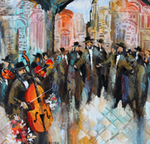
Michael Rozenvain
b. 1962
Ukrainian street and interior scene painter
Michael Rozenvain was born in 1963 in Kiev, Ukraine, studying art until his graduation from the Academy of Decorative Art. In 1990, he moved to Israel after the collapse of the USSR. In addition to his prolific paintings, he has also installed large murals and other decorative features in public buildings around Israel. He paints in many layers, creating a textured and lively surface.
|
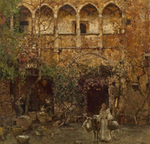
Robert Russ
1847-1922
Austrian architectural, urban genre, and landscape painter
Robert Russ was born in Vienna, Austria in 1847 into a family of artists. He studied landscape art at the Vienna Academy of Fine Arts under the direction of Albert Zimmermann. In 1871, Russ returned to the Academy to teach landscape painting. In 1880, he was awarded the Reichl Prize, and a year later, he was elected an honorary member of the Academy. Among his colleagues were Emil Jakob Schindler, Eugen Jettel, and Rudolf Ribarz. Russ is best known for watercolors, architectural views, urban genre scenes, and landscapes with figures, painted in a classical style. He drew inspiration from Austrian and Italian landscapes. His works are included in the collections of the Villa Borghese and Gardens in Rome, the Gratz in Vienna, and other museums throughout Europe. Russ is credited with having a major influence on Austrian landscape painting in the end of the 19th century and before his death in 1922.
|
| |
|
| |
|
|


